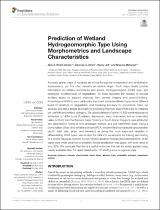| dc.identifier.citation | Rivers-Moore, N. A., Kotze, D. C., Job, N., & Mohanlal, S. (2020). Prediction of wetland hydrogeomorphic type using morphometrics and landscape characteristics. Frontiers in Environmental Science, 8 doi:10.3389/fenvs.2020.00058 | en_US |
| dc.description.abstract | Accurate spatial maps of wetlands are critical for regional conservation and rehabilitation assessments, yet this often remains an elusive target. Such maps ideally provide information on wetland occurrence and extent, hydrogeomorphic (HGM) type, and ecological condition/level of degradation. All three elements are needed to provide ancillary layers to support mapping from remote imagery and ground-truthing. Knowledge of HGM types is particularly important, because different types show different levels of sensitivity to degradation, and modeling accuracy for occurrence. Here, we develop and test a simple approach for predicting the most likely HGM type for mapped yet unattributed wetland polygons. We used a dataset of some 11,500 wetland polygons attributed by HGM types (floodplain, depression, seep, channeled, and un-channeled valley-bottom) from the Western Cape Province in South Africa. Polygons were attributed and described in terms of nine landscape metrics, at a sub-catchment scale. Using a combination of box-and-whisker plots and PCA, we identified four variables (groundwater depth, relief ratio, slope, and elevation) as being the most important variables in differentiating HGM types. We divided the data into equal parts for training and testing of a simple Bayesian network model. Model validation included field assessments. HGM types were most sensitive to elevation. Model predication was good, with error rates of only 32%. We conclude that this is a useful technique that can be widely applied using readily available data, for rapid classification of HGM types at a regional scale. © Copyright © 2020 Rivers-Moore, Kotze, Job and Mohanlal. | en_US |

